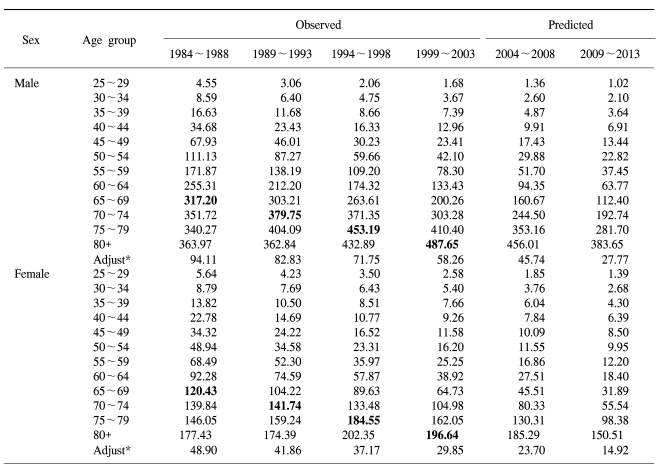Published: Cancer Res Treat. 2006;38(1):7-12
Received: 10 April, 2007, Accepted: 21 April, 2007
CORRECTIONS IN THE ABSTRACT
Purpose
In spite of gastric cancer's decreasing incidence and mortality rates, it is still the most common cancer in Korea. In the present study, weexamined the temporal trends of gastric cancer mortality during the past 20 years in Korea by using an age-period-cohort model, and we predicted the mortality rates for the next 10 years.
Materials and Methods
Data on the annual number of deaths due to gastric cancer and data on population statistics from 1984 to 2003 were obtained from the Korean National Statistical Office. A log-linear Poisson age-period-cohort model was used to estimate age, period and birth cohort effects. To project two periods (10 years) into the future, the new cohort values were estimated by performing linear regression that was applied to a chosen number of the most recent cohort values.
Results
The trends of gastric cancer mortality were predominantly explained by the cohort effect the risk of gastric cancer death decreased since the 1919 birth cohort for both genders. The predicted, expected age- adjusted mortality rates per 100,000 for males and females are 45.74 and 23.70, respectively, during 2004~2008, and 27.77 and 14.92 respectively, during 2009~2013. During 2004~2008 and 2009~2013, the predicted numbers of deaths due to gastric cancer in males are 36,940 and 27,967, respectively, whereas those in females are 19,658 and 14,843, respectively.
CORRECTIONS IN THE RESULTS
Table 1 shows the observed and predicted mortality rates for gastric cancer during 1984~2013 in Korea. For both genders, the observed mortality rates of gastric cancer decreased with the time period for the people with an age under 74, whereas they increased for the people with an age over 74. The observed age-adjusted gastric cancer mortality per 100,000 in men fell from 94.11 to 58.26 during the last 20 years. The predicted expected mortality rates per 100,000 for the males were 45.74 and 27.77 during 2004~2008 and 2009~2013, respectively. The observed age-adjusted cancer mortality per 100,000 for the females fell from 48.90 to 29.85during the last 20 years. The predicted expected age-adjusted mortality rates per 100,000 for the females are 23.70 and 14.92. during 2004~2008 and 2009~2013, respectively.
Table 2 shows the goodness of fit (scaled deviance) for the age-period-cohort models. Both the period and cohort effect were significant (p<0.001) after adjusting the age effect for the males and females. When the age-period-cohort model was compared with the age-cohort or age-period sub-model, only the cohort effect was significant for males, while both cohort and period effects were significant for females (p<0.05). The values of adj-R2A for the age-cohort model were almost same as those for the full models for both genders, suggesting the trend of gastric cancer mortality was explained enough by the age and cohort effect. Hence, the age-cohort models were adequate to preidct gastric cancer mortality in Korea, even though the period effect was significant in females. There was no reason to apply the full model, which had an unidentifiableproblem.
Fig. 1 shows the estimated cohort effects. The risk of gastric cancer death decreased since the 1919 birth cohort for both genders. These decreasing trends were extrapolated into the future for making predictions. The predicted cohort values are marked by open symbols in Fig. 1.
Table 3 shows the observed and the expected number of deaths. During the periods 2004~2008 and 2009~2013, the predicted numbers of deaths due to gastric cancer for males are 36,940 and 27,967, respectively, whereas those for the females are 19,658 and 14,843, respectively.














